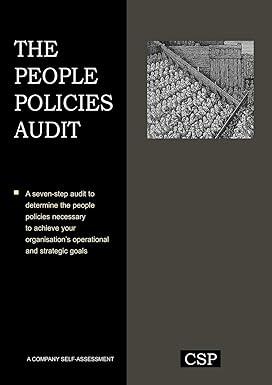Question
THE PROBLEM From 1996 through 2002, KPMG received $124 million in tax consulting fees from promoting tax shelters that allowed individuals and corporations to improperly
THE PROBLEM
From 1996 through 2002, KPMG received $124 million in tax consulting fees from promoting tax shelters that allowed individuals and corporations to improperly avoid more than $1.4 billion in federal taxes.7 E-mail messages obtained and released by the Internal Revenue Service indicated that KPMG officials were aware that the tax shelters were questionable.
As one example, a shelter referred to as bond-linked issue premium structures (BLIPS) created $5 billion in tax losses for investors. Under this shelter, clients would purchase foreign currency from offshore banks with funds borrowed from those same banks only to sell the currency back to the same bank a few months later. These investments were presented to the Internal Revenue Service as seven-year investments.8 Other shelters in question carried similar names such as FLIP, OPIS, and SOS.
THE OUTCOME
On August 26, 2005, KPMG admitted to criminal tax fraud and agreed to a payment of $456 million in penalties (an average of $300,000 per KPMG partner); the government agreed to deferred adjudication and, in January 2007, dismissed all criminal charges against the firm. Subsequently, Judge Lewis Kaplan of the U.S. District Court for the Southern District of New York dismissed indictments against 13 of 16 former KPMG partners and, on December 18, 2008, two of the remaining three partners were convicted on multiple counts of tax evasion. (The remaining partner was acquitted.)9
In the midst of this activity, federal prosecutors indicted four current and former partners of Ernst & Young on similar charges. The shelters designed and sold by these partners brought Ernst & Young $120 million in fees. Those familiar with the matter do not expect that the firm itself will face criminal charges in this matter10; however, on May 8, 2009, four current and former E&Y executives were convicted.
THE ISSUE
KPMG has avoided the fate of Arthur Andersen: dissolution. However, the KPMG case has raised numerous questions about the future of the accounting profession if the small number of international accounting firms should become even smaller. For example, the Securities and Exchange Commission discussed various actions to assist companies in changing auditors if KPMG was indicted, including allowing companies to seek waivers to the stricter independence rules on a case-by-case basis and allowing KPMG to continue to perform audits if it were indicted. An unidentified SEC official indicated that we have scenarios in place for any eventuality that could come out of this.11 In addition, prior to the settlement, Deloitte & Touche, Ernst & Young, and PricewaterhouseCoopers reportedly requested that their partners not solicit current KPMG clients.12
question:
Provide us a very high-level summary of the Issues in the Case Study (Think who, what, where, and when.)
Step by Step Solution
There are 3 Steps involved in it
Step: 1

Get Instant Access to Expert-Tailored Solutions
See step-by-step solutions with expert insights and AI powered tools for academic success
Step: 2

Step: 3

Ace Your Homework with AI
Get the answers you need in no time with our AI-driven, step-by-step assistance
Get Started


